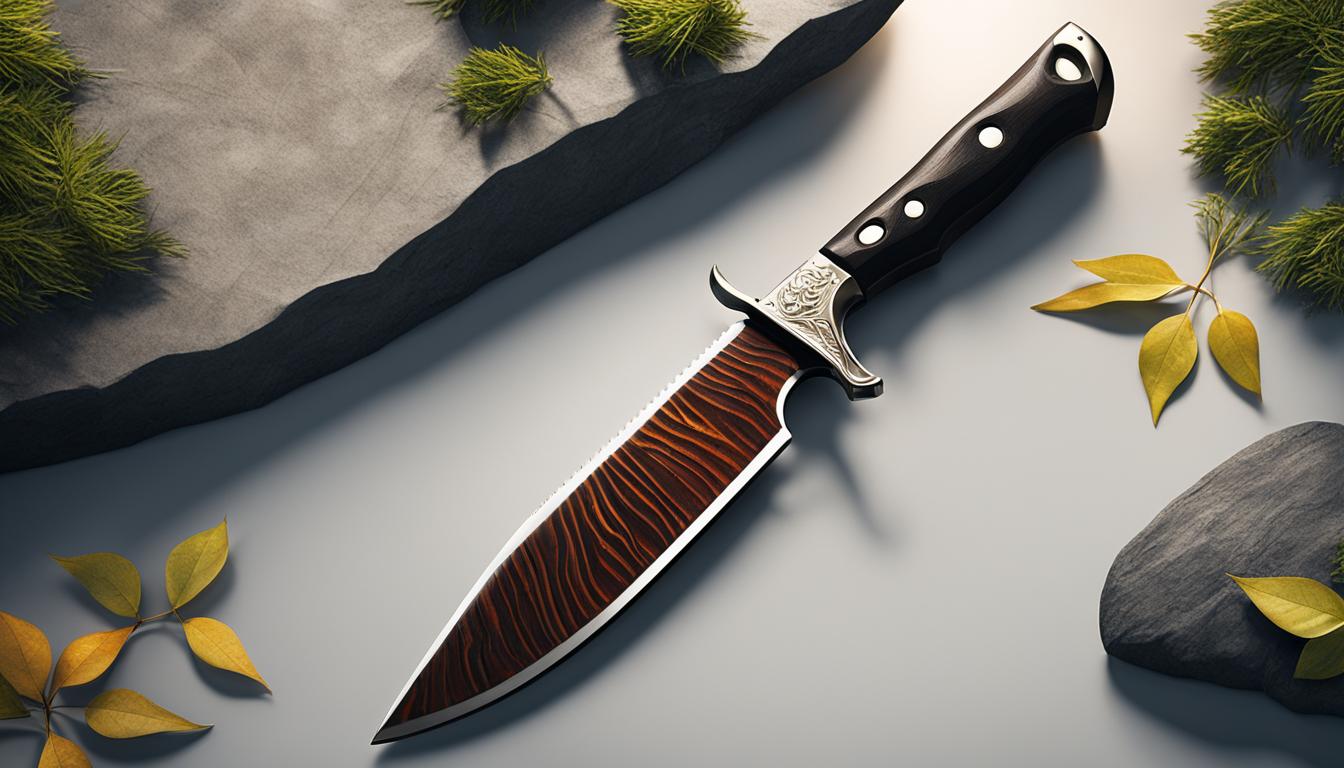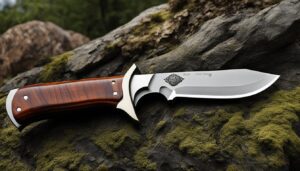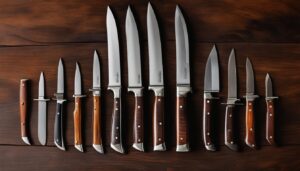As an avid hunting enthusiast, I understand the importance of having the right tools for the job. One essential tool that every hunter should consider adding to their collection is a partial tang hunting knife. These knives, known for their unique construction and versatility, offer a range of advantages that make them a must-have for any hunting expedition.
Key Takeaways:
- Partial tang hunting knives have a distinct construction where the tang does not extend through the handle’s entire length.
- They are lightweight and versatile, making them suitable for light to moderate cutting tasks.
- Partial tang knives may have limitations in terms of durability and balance but offer unique advantages for hunting enthusiasts.
- Consider your specific hunting needs and preferences when choosing between partial tang and full tang knives.
- Remember that a well-selected partial tang hunting knife can be a valuable addition to your hunting gear.
Understanding Full Tang Knives
Full tang knives are revered for their exceptional durability and robust construction. Unlike their partial tang counterparts, full tang knives feature a blade that extends the entire length of the handle, creating a solid, continuous piece of metal. This design ensures optimal strength and stability, making full tang knives highly reliable in demanding tasks.
The key advantage of full tang knives lies in their superior balance. The weight of the blade is evenly distributed throughout the handle, resulting in enhanced control and precision during cutting, chopping, and slicing. This well-balanced construction enables users to tackle various cutting tasks with ease, making full tang knives a popular choice in professional kitchens, outdoor adventures, and survival scenarios.
Whether it’s in the hands of a professional chef or an outdoor enthusiast, the durability of full tang knives is unmatched. Their solid construction allows them to withstand rigorous use and heavy-duty cutting without compromising performance. From slicing through thick cuts of meat to batoning firewood, full tang knives are designed to handle it all, making them a versatile tool for those who value strength and reliability in their cutting instruments.
| Advantages of Full Tang Knives | Disadvantages of Full Tang Knives |
|---|---|
| Exceptional durability | Relatively heavier compared to partial tang knives |
| Optimal strength and stability | Higher cost compared to partial tang knives |
| Improved balance for enhanced control and precision |
Overall, full tang knives are the go-to choice for those seeking knives with unmatched durability, strength, and balance. While they may be relatively heavier and costlier compared to partial tang knives, the benefits they offer in terms of reliability and performance make them a worthwhile investment for individuals who demand the best out of their cutting tools.
Exploring Partial Tang Knives
Partial tang knives have a unique construction where the tang extends only partially into the handle, leaving a significant portion hollow or filled with materials like plastic or wood. This construction has its limitations that can impact the overall performance and durability of the knife.
One of the primary limitations of partial tang knives is their structural weakness, especially under heavy use or when exposed to lateral forces. The shorter tang length reduces the knife’s stability and increases the risk of breakage. This weakness can compromise the knife’s ability to handle demanding tasks and reduce its overall longevity.
Another aspect affected by partial tang construction is the knife’s balance. With a shorter tang, the weight distribution can be uneven, impacting the knife’s maneuverability, precision, and control during cutting tasks. The imbalanced weight distribution can make it challenging to achieve accurate and consistent cuts, leading to potential safety concerns.
Table: Partial Tang Knives vs. Full Tang Knives
| Factors | Partial Tang Knives | Full Tang Knives |
|---|---|---|
| Construction | Partial tang extends partially into the handle | Tang extends the entire length of the handle |
| Limitations | Structural weakness, compromised durability | N/A |
| Balance | Imbalanced weight distribution | Even weight distribution |
Partial tang knives offer lightweight and versatile options for light to moderate cutting tasks. However, their construction limitations, including structural weakness and imbalanced weight distribution, make them less suitable for heavy-duty use. For those seeking a reliable and durable option, full tang knives provide enhanced strength, durability, and balance.
It’s essential to consider the specific requirements and intended use of the knife when choosing between partial tang and full tang knives. While partial tang knives can be a more affordable option and suitable for lighter tasks, full tang knives are recommended for their superior durability and balance, making them ideal for demanding cutting and chopping tasks. By understanding the strengths and weaknesses of each construction, individuals can select the right knife that aligns with their needs and expectations.
Benefits and Drawbacks of Full Tang and Partial Tang Knives
When it comes to choosing a hunting knife, understanding the benefits and drawbacks of both full tang and partial tang knives is essential. Each type of knife has its unique features and characteristics that cater to different needs and preferences.
Strength and Durability: Full tang knives are known for their exceptional strength and durability. The blade extends fully through the handle, creating a solid and sturdy construction. This design ensures that the knife can withstand heavy-duty tasks and resist breakage even under extreme pressure. On the other hand, partial tang knives have a tang that extends only partially into the handle, which can make them more susceptible to structural weakness and potential breakage.
Balance and Lightweight: Full tang knives often offer better balance due to the weight distribution throughout the blade and handle. This balanced design provides enhanced control and precision during cutting tasks, making them popular among professionals. However, full tang knives can be heavier compared to partial tang knives. Partial tang knives, on the other hand, are lightweight and versatile, making them suitable for light to moderate cutting tasks.
When considering a hunting knife, it’s important to evaluate your specific needs and preferences. If you prioritize strength, durability, and balance, a full tang knife may be the ideal choice for you. On the other hand, if lightweight and versatile functionality are more important, a partial tang knife can meet your requirements. Ultimately, the choice between full tang and partial tang knives depends on the specific tasks and conditions you anticipate encountering during your hunting adventures.
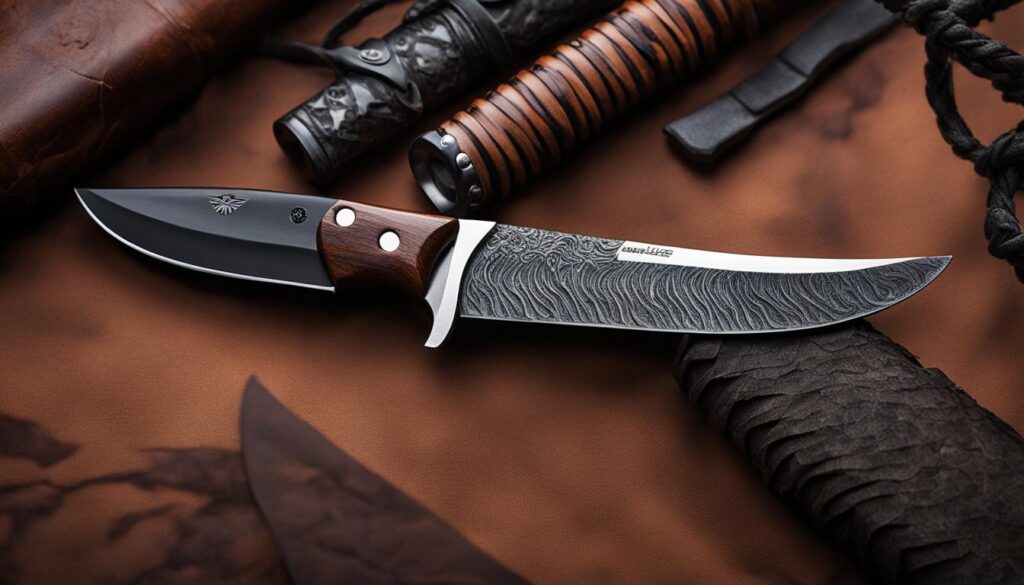
Table: Full Tang vs. Partial Tang Knives Comparison
| Features | Full Tang Knives | Partial Tang Knives |
|---|---|---|
| Strength | Exceptional | Lower |
| Durability | Highly durable | More prone to breakage |
| Balance | Well-balanced | May be affected by shorter tang |
| Weight | Heavier | Lightweight |
| Suitable For | Demanding tasks, professionals | Light to moderate cutting tasks |
Choosing the Right Tang for Different Knives and Uses
When selecting a knife, it is important to consider the type of tang that best suits your needs. Different knives serve different purposes, and the choice of tang construction can greatly impact their performance and longevity. Let’s explore the ideal tang options for various types of knives:
Chef’s knives and Kitchen cutlery
In the culinary world, full tang knives are highly recommended for chef’s knives and kitchen cutlery. These knives often undergo rigorous use, including chopping, slicing, and dicing various ingredients. The full tang construction provides exceptional durability, ensuring that the knife can withstand the demands of a busy kitchen. Additionally, the balanced weight distribution and stability of a full tang knife enable better control and handling, allowing chefs to execute precise cuts effortlessly.
Hunting and survival knives
When it comes to hunting and survival knives, full tang options are the preferred choice. These knives need to withstand harsh outdoor conditions and perform tasks such as field dressing, skinning, and wood processing. The solid construction of full tang knives ensures that they are up to the challenge, providing the necessary strength and reliability. Whether you’re deep in the wilderness or on a hunting expedition, a full tang knife will be your trusted companion.
Tactical and combat knives
In tactical and combat scenarios, both full tang and partial tang knives can be suitable, depending on the specific requirements. Full tang knives offer robustness and balance, making them suitable for combat operations and survival situations. On the other hand, some tactical knives are designed for lightweight and discreet carry, where partial tang construction can provide the desired weight reduction without compromising the knife’s functionality. The choice between full tang and partial tang in this context depends on factors such as mission requirements and personal preferences.
Custom and handmade knives
When it comes to custom and handmade knives, the tang construction can vary based on the knife maker’s design philosophy and intended purpose. Some custom knife makers prefer the solid and durable nature of full tang knives, while others may experiment with partial tang options to achieve specific weight or balance characteristics. If you’re investing in a custom or handmade knife, it’s essential to communicate with the knife maker about your specific needs and preferences to ensure that the tang construction aligns with your expectations.
| Knife Type | Ideal Tang Construction |
|---|---|
| Chef’s knives and Kitchen cutlery | Full tang |
| Hunting and survival knives | Full tang |
| Tactical and combat knives | Full tang or partial tang, depending on specific requirements |
| Custom and handmade knives | Varies based on knife maker’s design philosophy and intended purpose |
By understanding the different tang options and their suitability for various knives, you can make an informed decision when selecting the right knife for your specific needs. Whether you’re a chef, an outdoor enthusiast, or a collector, choosing a knife with the appropriate tang construction ensures optimal performance and longevity.
Identifying the Type of Tang in a Knife
When examining a knife, it’s important to understand the type of tang it possesses. The tang refers to the portion of the blade that extends into the handle. By visually assessing certain cues, you can determine whether a knife has a full tang or a partial tang construction.
Visual Indicators
One of the key visual indicators is whether the tang is exposed or enclosed. In full tang knives, the tang is often visible along the spine and sometimes the bottom of the handle, creating a seamless extension of the blade. On the other hand, partial tang knives have the tang inserted into the handle, and it may not be visible externally.
Handle construction and attachment can also provide clues about the type of tang. Full tang knives typically have handles secured with pins or rivets, indicating a solid construction that enhances durability and stability. In contrast, partial tang knives may have handles attached with adhesives or fasteners, which can suggest a less robust construction.
Weight Distribution and Balance
Weight distribution and balance are important factors to consider when identifying the type of tang in a knife. Full tang knives generally have better weight distribution throughout the blade and handle due to their solid construction. This balanced weight distribution contributes to improved control and maneuverability during cutting tasks.
On the other hand, partial tang knives may have a different weight distribution, which can affect their balance. The shorter tang length and potentially hollow handle can impact the knife’s overall balance, making it feel lighter or less stable in the hand.
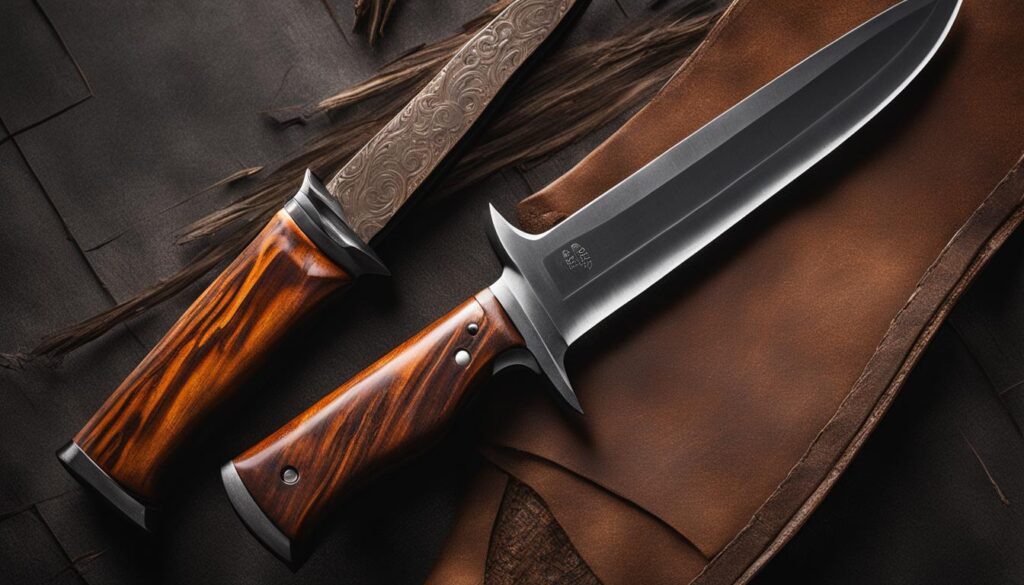

Identifying the type of tang in a knife is essential for understanding its overall construction and performance capabilities. By considering visual cues such as tang exposure, handle construction, weight distribution, and balance, you can make informed decisions when selecting a knife that aligns with your needs and preferences.
Conclusion
After exploring the advantages and drawbacks of full tang and partial tang knives, it is evident that both types have their own unique qualities. Full tang knives boast exceptional durability, strength, and balance, making them a reliable choice for various applications. On the other hand, partial tang knives offer versatility and lightweight design, making them suitable for lighter cutting tasks.
When it comes to knife selection, it is essential to consider the specific requirements and intended use. For those seeking long-lasting performance and longevity, a full tang knife would be an excellent choice. However, if you are looking for a specialized tool or prefer a lighter option, a partial tang knife can still serve your needs effectively.
Remember, the right tang type plays a significant role in a knife’s performance and longevity. Factors such as knife type, intended use, and personal preferences should guide your selection process. By carefully considering these factors, you can choose the ideal full tang or partial tang knife that aligns perfectly with your needs and expectations.
FAQ
What is the difference between a full tang and a partial tang knife?
Full tang knives have a blade that extends the entire length of the handle, while partial tang knives have a tang that does not extend through the entire handle.
Are full tang knives more durable than partial tang knives?
Yes, full tang knives are known for their exceptional durability due to their solid construction.
Do partial tang knives offer better balance?
Partial tang knives may have limitations in terms of balance, as their shorter tang length can affect maneuverability and control.
Are full tang knives suitable for professional kitchens?
Yes, full tang knives are highly recommended for professional kitchens due to their durability, balance, and stability.
Are partial tang knives suitable for hunting and survival purposes?
Partial tang knives can serve hunting and survival purposes well, but their limitations in terms of durability should be considered.
How can I identify the type of tang in a knife?
Full tang knives have the tang exposed along the spine and sometimes the bottom, while partial tang knives have the tang inserted into the handle and may not be visible. Handle construction and weight distribution can also provide clues.
What factors should I consider when choosing a tang for a knife?
Factors such as knife type, intended use, and personal preferences should guide the selection process. Durability, balance, and performance should be taken into account.
